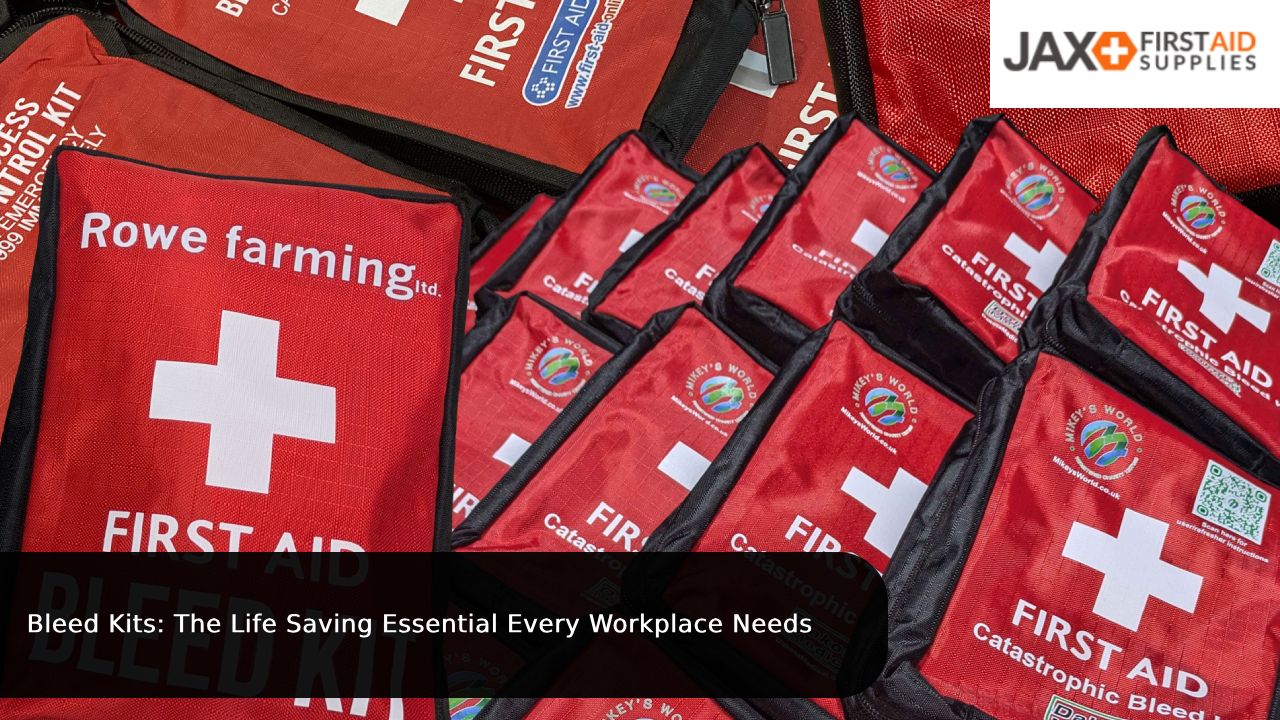Bleed Kits: The Life Saving Essential Every Workplace Needs
Published by Jax First Aid Supplies on 2nd Apr 2025
What is a Bleed Kit?
A bleed kit is a first aid kit specifically made to give life-saving support in a severe bleeding emergency. UK Ambulance Services typically reach a Category 1 (life-threatening) 999 calls on an average of 8 minutes, though actual response times can vary. However, when dealing with catastrophic bleeding every second counts and can mean the difference between life and death. Unlike a regular first aid kit, bleed kits include more advanced tools to manage catastrophic blood loss emergencies, which is a leading cause of death in accidents, violent incidents, or industrial injuries. A bleed kit is compact, portable, and should contain the most essential items for severe bleeding emergencies. When purchasing a bleed kit, it is important to make sure all components of the kit, especially tourniquets and haemostatic dressings, are CE-marked or UKCA-certified for medical use in the UK.
Why are bleed control kits so important?
In certain emergencies where every single second counts, having a bleed kit can be the difference between life and death. Severe bleeding can result in death within a matter of a few minutes, and fast actions and the right equipment is crucial. A bleeding control kit is made to give bystanders or trained first aiders the chance to act immediately, keeping the individual alive until an ambulance and paramedics arrive at the scene, which according to NuffieldTrust, can take up to 8 minutes on average as of January 2025. With items such as pressure dressings and tourniquets, a bleed control kit provides the most essential resources to control bleeding and save lives.
What is the difference between a bleed control kit and a regular first aid kit?
While a regular first aid kit is great for treating smaller injuries, (e.g. cuts, scrapes, or burns), a bleed control kit contains first aid supplies specifically made for managing severe blood loss. Key differentiations between the two include:
-
Tourniquets: Bleed kits have high-quality tourniquets for stopping arterial bleeding.
-
Haemostatic Agents: Bleed control kits contain a special gauze that is infused with clotting agents, which accelerates the body's natural blood clot process.
-
Trauma Dressings: Trauma dressings are designed for severe, bleeding wounds, and give extra compression and absorbency to stop immense bleeding.
-
A Focused Purpose: While regular first aid kits can be multipurpose, bleed kits specifically have a focus on severe trauma care.
What environments require a bleed kit?
Workplaces and Environments:
-
Construction Sites: High-risk construction work where heavy machinery and tools are being used increase the likelihood of severe injuries.
-
Factories and warehouses: Factories or warehouses with sharp or extremely heavy or dangerous equipment and hazardous materials.
-
Schools: Mainly in times where students or children will be using sharp, or dangerous equipment for sport or science.
-
Event venues: Places in which there is a large gathering of people, a fall or fight can lead to severe bleeding from the head.
-
Offices: While seemingly low-risk, accidents can still happen every day, making these bleed kits a good addition to have. It is better to be prepared than to not be prepared at all.
- Farms: Agricultural workplaces have numerous hazards and equipment that can lead to severe injuries. From heavy machinery accidents to injuries from sharp tools, livestock incidents, or even falls, farms are a high risk workplace, where fast access to a bleed kit can be life saving.
Public and Private Sectors:
-
Emergency Services: Police, fire, and ambulance teams tend to use blood control kits very often for emergencies.
-
Transport Operators: This includes taxis, buses, boats and airlines.
-
Hotels, Motels and Airbnb's: While technically not a legal requirement, having a bleed control kit within public or private accommodation can show strong safety preparedness, especially in larger or high-traffic venues.
Legal and Safety Standards
While bleed control kits are not actually legally required in most workplaces, UK law does require employers to assess their workplace's risks and supply adequate first aid supplies based on a risk assessment. However, by keeping a bleed control kit, businesses show a commitment to the safety of their employees, as well as customers.
What are the benefits of having a bleed control kit?
-
Prepared and safe: Being prepped for severe trauma emergencies reduces the risk of an accident turning into something a lot worse.
-
Legal: Meeting all health safety requirements makes sure your business is adhering to the law.
-
Employee security: Employees will feel much more secure knowing that their workplace is prepared if, worst case, they get in a traumatic emergency.
Choosing the right bleed control kit:
When choosing the right bleed control kit for you, consider the following:
-
Contents: Make sure the kit contains essential equipment, including tourniquets, haemostatic dressings, and tuff cut shears.
-
Portable: Compact and light designs for easy access and transportability.
-
Certifications: Ideally, look for bleed kits that meet recognised safety standards.
-
Build Your Own: A build your own bleed kit is a great option for those who want their own organisation of a bleed kit with more or less of certain items. It may be worth consulting a competent first aider or follow HSE/BSI guidelines when assembling your own bleed kit.
Bleed control kits are crucial for severe injuries and saving lives. Their importance extends across all environments, from high risk construction sites to everyday settings. By having a bleed control kit, you’re equipping yourself and your team with a way to respond effectively in critical situations.









